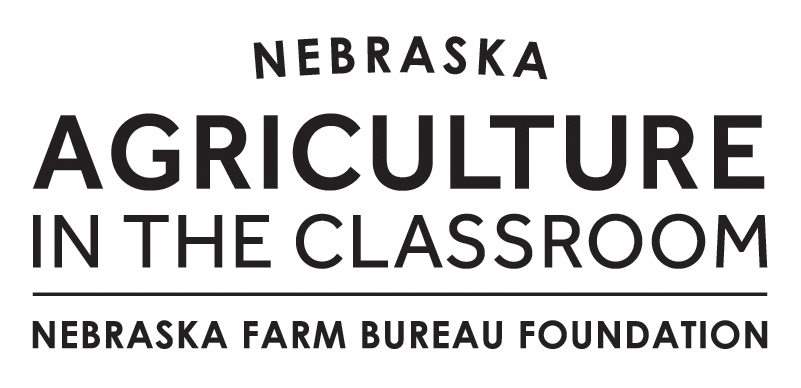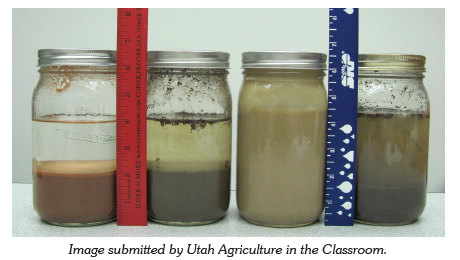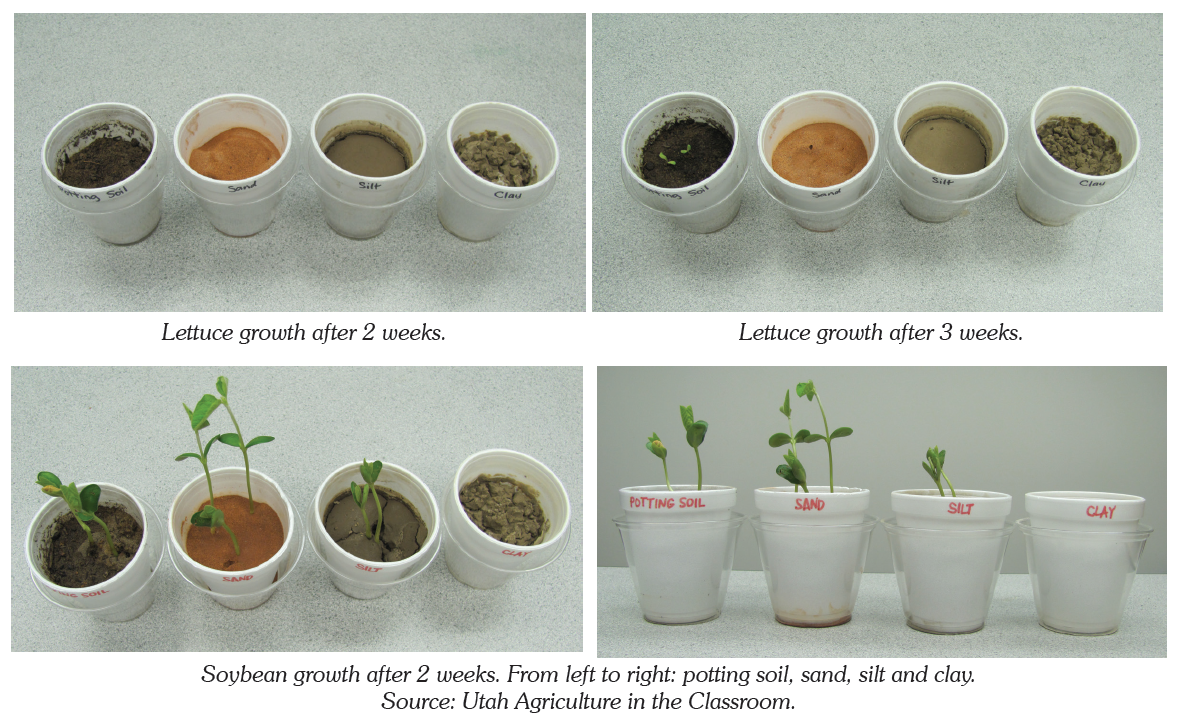Lesson Plan
Texturing: The Big Picture
Grade Level
Purpose
Students explore soil textures and investigate the connections between soil texture, water, and plant growth. Grades K-2
Estimated Time
Materials Needed
Engage:
- 2" x 1.5" sticky notes in four colors
- Magazine pictures (optional)
Activity 1: Sandpaper Texture
- 60, 220, and 1000 grit sandpapers, 4 sheets of each*
- Hand lenses, 1 per pair of students*
*These items are available in a Sandpaper Texturing Kit which is available for purchase from agclassroomstore.com
Activity 2: Dirt Shake Demonstration
- 4 jars with tightly fitting lids
- 4 soil samples (sand, silt, clay, and loam)**
- 1 ruler
Activity 3: Which Soil is Best?
- 6 Styrofoam cups
- 6 clear cups (to hold Styrofoam cups)
- 2 cups of sand**
- 2 cups of silt**
- 2 cups of clay**
- 9 bean (or other large) seeds
- 9 lettuce (or other small) seeds
**These items are available in a Soil Sample Kit which is available for purchase from agclassroomstore.com.
Vocabulary
clay: the smallest of the three soil particle sizes; measuring less than 0.002 mm
loam: ideal garden soil that has a well-balanced mixture of sand, silt, and clay
organic matter: a soil component derived from the decay of once-living organisms like plants and animals
rock: the solid mineral material that forms part of the earth’s surface
sand: the largest mineral soil particles, measuring between 2.00 and 0.05 mm
silt: sedimentary material composed of fine mineral particles in size between sand and clay
soil: a mixture of minerals, organic matter, water, and air, which forms on the land surface and can support the growth of plants
texture: the feel, appearance, or consistency of a surface or substance
Did You Know?
- Soil is a natural resource consisting of weathered rock particles, organic matter, air, and water.1
- Soil is considered a non-renewable resource because it does not renew itself at a sufficient rate in the human time frame.1
- One centimeter of soil can take hundreds to thousands of years to form from parent rock.1
- Soils are the basis for the production of food, fibers, fuel, and medicinal products.1
Background Agricultural Connections
Soil is the foundation for agriculture. We need soil to grow the plants we eat, the plants we wear (cotton and linen), the plants that provide us materials to build shelter, and the plants we use for thousands of different applications. Soil is composed of four elements: air, water, organic matter (decomposed material from once-living organisms), and non-living mineral particles (tiny pieces of weathered rock).
There are many different types of soil around the world. One simple and informative way to classify soils is by texture, which is determined by the size of the mineral soil particles. Soil particles come in three sizes: sand, the largest, followed in descending size by silt and clay. Clay is so small that the particles are actually impossible to see without magnification. Amazingly, you can feel the difference! A sandy soil feels gritty, and a clayey soil feels smooth and sticky. A soil with a mixture of all three particle sizes in about equal proportions is called a loam. This is the most desirable texture for growing crops because it holds just the right amount of water—not too much and not too little.
The texture of a soil determines how water will move through it. Water moves through clay very slowly because the spaces between the particles are very small, and the particles themselves actually attract water. Once wet, a clayey soil will take a long time to dry out. Nonetheless, it can be difficult for plant roots to access the water that is tightly held in clayey soil. In contrast, water moves very quickly through sandy soil. This means that the water is easy for plant roots to access, but the soil can dry out very quickly, leaving plant roots dry and thirsty if water isn’t applied frequently.
Air exists in the pore spaces between the soil particles. When a soil is dry there is more air in the soil, but when wet, there is very little air in the soil because the water has filled in the spaces! Soil is rarely completely dry; there is usually at least a small amount of moisture in soil. Some plants are aquatic and thrive in saturated soils, but many others do not. Most land-based plants need air in the soil to grow.
It is important for farmers to know the texture of their soils, so that they know what kinds of plants will grow well in them and how to irrigate. To determine the texture of a soil, farmers and soil scientists perform a type of “dirt shake” (hydrology test) in which soil particles are separated into water and then allowed to settle out over time. Because they settle at different rates, this allows for the measurement of the sand, silt, and clay content in a soil sample.
Hand texturing (using the hands to feel the soil) confirms the texture of a soil, and is used widely in the field when a hydrologic “dirt shake” test is not practical. Sand, whether dry or wet, is gritty. Silt, when dry, feels soft and powdery, when wet it feels smooth and slick. Clay is usually hard and clumped when dry, but if ground down it is also powdery like silt. When clay is wet it becomes very sticky and may stain your fingers, and this is the best way to tell silt and clay apart. Stepping into and then out of a wet clay soil can pull your shoe off! Clay mineral particles all have a great affinity for water. Some swell easily and may double in thickness when wet. Water molecules are strongly attracted to clay mineral surfaces. When a little clay is added to water, a slurry forms because the clay distributes itself evenly throughout the water. This property of clay is used by the paint industry to disperse pigment (color) evenly throughout a paint. Without clay to act as a carrier, it would be difficult to evenly mix the paint base and color pigment. A mixture of a lot of clay and a little water results in a mud that can be shaped and dried to form a relatively rigid solid. This property is exploited by potters and the ceramics industry to produce plates, cups, bowls, and so on.
Soil texture cannot be determined by the color of the soil. There is red sand in Utah and red clay in Oklahoma. The color of a soil is based on the amount of organic matter in the soil and the types of minerals in the rocks (parent material) from which the soil originated.
Engage
Ask students to draw pictures or cut out pictures from magazines of things they have used or eaten in the last week. To accelerate the activity, you may provide images of items to the students.
- Have each student choose one picture to share with the class. Explain to students that you will be graphing the natural resources used to make the things they use every day. A natural resource is something found in nature that is valuable to humans, like rocks, soil, and water, which are necessary to make most of the things we use and eat.
- Assign a different color of sticky note to represent rocks, soil, water, and a combination of these resources. The colored sticky notes will be used to create a graph. Draw the graph axes on the board and label the different categories.
- Share a few examples to begin: a food (made from plants or animals that eat plants—comes from soil and water), something made from plastic (made from oil, which comes from ancient, decayed plants and animals now buried deep underground—soil and water), something made from metal (made from minerals—come from rocks), and piece of clay pottery (made from soil). Place a correspondingly colored sticky note in each category for the example items you share.
- Have each student share their chosen item, and decide if the item needed rocks, soil, water, or a combination of these resources. As the students identify the resources their item used, provide each student with a corresponding color of sticky note.
- Ask students to help you place the sticky notes in the appropriate place on the graph you have constructed.
- Review the graph for trends that appear. It is likely that the items students use every day require soil and water!
Explore and Explain
Activity 1: Sandpaper Texturing
In preparation for this activity, fold each sandpaper sheet into four quarters, and then cut or tear the sections apart so that you get four pieces from each sheet.
- Divide students into groups of three or four and provide each group with a sample of the 1000, 220, and 60 grit sandpaper and a few hand lenses.
- Explain to students that texture is a characteristic that can be seen and felt. Ask students to touch each sample and to place them in order, from grittiest (coarsest or roughest) to the softest (smoothest) texture.
- To check their accuracy, ask students to use a hand lens to look at the grit on each sample and verify that they have the samples in the correct order—largest, grittiest particle to smallest, smoothest particle. If students have the sandpaper in the correct order, they are on their way to being able to texture soil by feel.
- Explain to students that sandpaper is not made out of soil particles. However, similar to the sandpaper, soils have different sizes of mineral particles. Some have large particles and feel gritty. Others have small particles and feel smooth. Most soils have a combination of particle sizes, falling somewhere between smooth and gritty. The size of mineral particles in a soil determines its texture.
Activity 2: Dirt Shake Demonstration
- In preparation for this activity, gather four different types of soil, preferably finding one that contains more sand, one that contains more silt, one that contains more clay, and one that is a mixture “garden soil” or loam. (You may purchase soil samples that have been evaluated as primarily sand, silt and clay through the link provided under Materials; these pure samples will make it easy for your students to see the differences between textures).
- Explain to students that you are going to demonstrate another way (in addition to feel) to determine the texture of soil. Soil particles are classified into three different sizes: sand is the largest particle, silt is the medium size, and clay is the smallest. In water, the largest particles will sink the fastest.
- In order to determine the texture of each sample, measure and place two inches of each sample into its own individual jar.
- Explain to students that soil also contains air. Although air is invisible, when water is added to the soil sample, they should be able to see air bubbles rising to the top.
- Add water to each jar so that the jar is two-thirds to three-fourths full. Point out the air bubbling to the top. The air that was held between the soil particles has been displaced, or forced out, by the water.
- Tighten the lids and ask for student volunteers to shake the jars. Ask for another volunteer to be the time keeper.
- Instruct students to shake the jars vigorously until all the particles have been sufficiently separated by the water. This will take two minutes. Ready, set, shake! (Note: Soil scientists using this test shake soils for 24 hours—it can take this long to break apart some clay particles, but in the classroom you will have adequate results from a short amount of shaking.)
- After two minutes, have the students set the jars down. The time keeper should keep timing. Allow the soil to settle for one minute, and then measure the amount of soil on the bottom of the jar. This is the sand—the largest mineral particles in the soil. Record this information.
- The next layer to settle will be the silt. Measure the level of the settled soil again after three to four hours to see how much silt is in each sample. The clay particles will be the last to settle and may take a day or more to form the last layer (some very clayey samples could take a week or more). Measure this layer when the time comes.
- Compare the measurements from the different soils. A soil scientist will be able to use the measurements to determine the actual soil texture, but for young students, just seeing the differences will be meaningful. (Note: If you purchased clay, silt, and sand samples, the greatest layer distinction will be in the “garden” loam soil jar because the other samples are fairly pure.)
- Your students may observe “stuff” floating on the surface of the water. This “stuff” is the “once-living” component of the soil—the organic matter. If you make a dirt shake out of potting soil from a bag you will notice that the entire sample will float. Why? Because there are no mineral particles, just organic matter!
- Remind students of the graph you made at the beginning of the lesson. Most of the everyday items required soil and water to be made. Explain that the texture of the soil affects how it holds water. A soil with very small (clay) particles holds a lot of water. A soil with large (sand) particles lets the water drain through very quickly. Texture affects what kinds of plants will grow best in the soil. All plants need water to grow, but some need more than others.
Activity 3: Which Soil is Best?
- To demonstrate how different soil types may affect plant growth, plant a large seed (bean) and a small seed (lettuce) in separate containers of sand, silt, and clay. Use the following procedure:
- Poke three holes of the same size in the bottom of six Styrofoam cups.
- Next, fill each cup with soil to within two inches of the brim so that you have two cups of each soil type.
- Plant three bean seeds in one cup of each soil type. Plant three lettuce seeds in each of the remaining three cups. (Note: Don’t bury lettuce seeds too deep; simply place them on top of disturbed soil and water them in. Bean seeds can be planted ½ to 1 inch deep)
- Place the Styrofoam cups into clear plastic cups to collect any water that may drain out.
- Water with 40 ml (about 3 tablespoons) every four days. Note how the different soil types absorb the water or let the water flow through. Do all the soils look like they need water after four days? Discuss what might happen if you didn’t water for another week.
- Ask students to predict how the different seeds may react to the different soils. Do they have any predictions? What are their predictions based on? Examine the size of the seeds—are big seeds stronger than smaller seeds? Consider the texture of the soils—do some soils hold more water than others?
- Be sure to observe the cups each day. Are some textures drying out more quickly than others? How does this affect the seeds? (Note: There are many variables that can affect seed germination and plant growth, so you will want to make sure that the cups are kept close together and experience similar light and temperature levels. This “controlled” experiment doesn’t exactly duplicate what is seen in a farmer’s field. The intensity of the sun or wind may bake and dry a clay soil and cause a crust to form on the top of a soil, keeping a seed from sprouting. Also, clay soils take longer to dry out than a sandy soil, so if the weather is particularly wet, a seed may rot before it can sprout. These are just some of the variables farmers work with to grow the crops that provide us with food, fiber, and other materials)
Elaborate
Emphasize the uses and importance of soil by viewing the sing-along song Dirt Made My Lunch by the Banana Slug String Band.
Evaluate
After condusting these activities, review and summarize the following key concepts:
- We need soil to grow plants for food, fiber, and items we use every day.
- Soils can be classified by texture, which is determined by the size of the mineral soil particles—sand, silt, and clay.
- The texture of soil determines how water will move through it.
- It is important for farmers to know the texture of their soil, so they know what kinds of plants will grow well in them and how to irrigate.
Recommended Companion Resources
Author
Organization
| We welcome your feedback! If you have a question about this lesson or would like to report a broken link, please send us an email. If you have used this lesson and are willing to share your experience, we will provide you with a coupon code for 10% off your next purchase at AgClassroomStore. |



